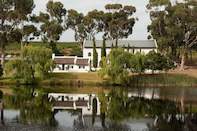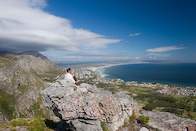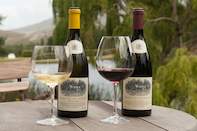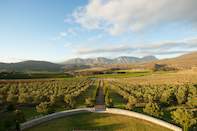Anthony Hamilton Russell’s philosophy of ‘expressing a sense of place’ infuses everything he does here, including producing two iconic wines.
Low-key Elegance

Just over the mountain behind the town of Hermanus on Walker Bay - one of the world’s top whale-viewing sites - you’ll find the rugged Hemel-en-Aarde Valley. And tucked away in the valley lies the unassuming home of Hamilton Russell Vineyards’ duo of iconic wines.
Wind your way up a farm road lined with cypresses and olive trees set among the vineyards. Beneath giant sugar gums stand two whitewashed, iron-roofed farm buildings. Next to them is a tiny thatched cottage overlooking a tranquil dam and pine-covered hill.
You’ll be welcomed into the restored, hobbit-sized cottage with a glass of chilled Hamilton Russell Vineyards Chardonnay, its trademark elegance disguising a mouthful of fruitiness (with a hint of mineral), bracing acidity and toasted oak. No mere sip this, but a generous pour in big-bowled, designer stemware.
Savour it on the stoep overlooking the dam (a good spot for birdwatching) or on a leather sofa in front of the hearth. Then try a glass of Hamilton Russell Vineyards Pinot Noir, famously endowed with fruit and tannin, and that distinctive minerality.
Hemel-en-Aarde Valley Pioneer

A wall-mounted map meticulously lays out the various vineyard blocks and an aerial photograph shows the farm in relation to the area. Advertising executive Tim Hamilton Russell bought this undeveloped, 170-hectare piece of land in 1975, intent on finding the most southerly vineyard site in South Africa in order to produce the classic wines that only a cool climate can deliver.
When son Anthony took over in 1991, he started focusing on soil rather than climate, convinced that this was what set the farm and its wines apart.
Extensive soil mapping and separate vinification of grapes from different vineyard blocks eventually resulted in just 52 hectares of clay-rich, shale-derived soils being set aside.
They alone would nourish the Chardonnay and Pinot Noir, Hamilton Russell Vineyards’ two Burgundian classics, which were to be crafted by Hannes Storm.
Storm was only the third winemaker to nurture the Hamilton Russell wine, following in the footsteps of Kevin Grant and, before that, founding cellarmaster Peter Finlayson, both of whom had moved on to establish their own vineyard ventures in the valley as the valley’s enormous viticultural potential was realised, as did Storm.
Incumbent Emul Ross has been in residence since 2015, supported by long-time viticulturist Johan Montgomery.
Master Class

By the second glass of your tasting overlooking the farm dam, the Pinot Noir, the unhurried air typical of Overberg farm life will have worked its magic.
Serious wine lovers and buyers are advised to pre-arrange their visit and book a cellar tour, preferably for when Anthony is taking a break from his international wine travels.
You’ll find yourself amid barrels of maturing wine in the cool, dim underground cellar, experiencing a vertical tasting of the three latest vintages of both Hamilton Russell Vineyards’ wines.
If you and your party give yourselves over to passionate discourse (and Anthony’s not yearning for his cigar), he may uncork an older vintage, just to track the evolution of style or illustrate a subtle change in the making regime or a variation in vintages.
From there will he may escort (or direct) you up the track to (or past) Braemar, his Georgian-style hillside manor set in an olive grove. These and other olive orchards on the property yield fruit that are cold-pressed for extra-virgin olive oil under the Hamilton Russell label.
Also ask whether copies of the book A Year on a Cape Wine Estate – Entertaining at Hamilton Russell Vineyards, are available. Compiled by wife Olive, the seasonal selection of dishes that incorporate local produce such as waterblommetjies (Cape pondweed) in risotto and ravioli stuffed with freshly harvested alikreukel (periwinkles).
She uses wild suurvygies (sour figs) in malva pudding (a traditional Cape dessert) and fragrant kooigoed (a medicinal renosterveld plant) in a mayonnaise for grilled line fish. Hamilton Russell’s own raw fynbos honey appears in anything from sauces for crayfish to ice cream, while Olive’s oil of choice is, naturally, the fruity estate-grown and unfiltered extra-virgin olive oil.
Supporter of the Biodiversity

An early supporter of the Biodiversity & Wine Initiative, with HRV earning WWF-SA Conservation Champion status, Anthony has established a 38-hectare fynbos reserve, two wetlands and two bio-diversity sites on these mountains.
They are home to several types of small buck, more than 120 bird species, bat-eared foxes and, increasingly, a shy Cape mountain leopard or two, re-emerging here and elsewhere in the winelands as a result of efforts by the Cape Leopard Trust with collaborative wine farmers.
 Across the Hottentots Holland Mountains range over Sir Lowry’s Pass lies the Winelands of Overberg a high, rocky plateau where timber plan...
Across the Hottentots Holland Mountains range over Sir Lowry’s Pass lies the Winelands of Overberg a high, rocky plateau where timber plan...